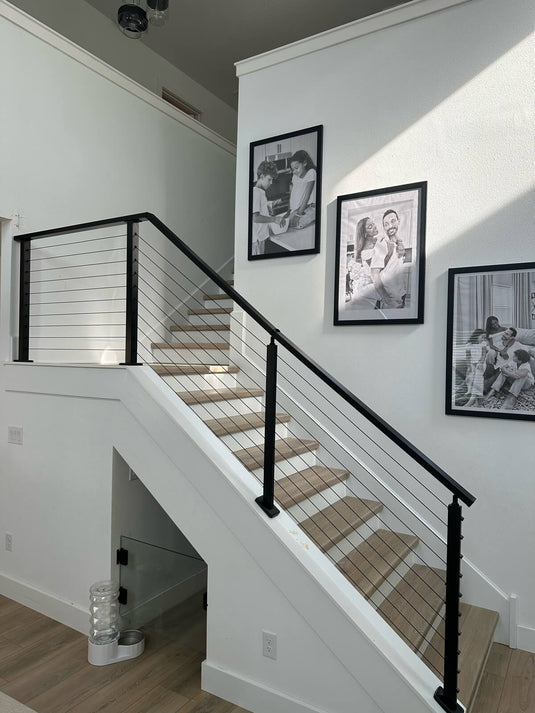TABLE OF CONTENTS
Pros and Cons of Cable Railing
A cable railing is a guardrail system composed of metal cables and posts, commonly used for stairs, patios, decks, balconies, or garden fences where safety is required. Its main feature is the use of metal cables instead of traditional vertical bars, protecting while ensuring structural stability and safety.
Cable railing systems offer a transparent visual effect and a sleek appearance, ensuring an open view. They are durable and easy to maintain, making them increasingly popular and widely used in both residential and commercial projects.
Is a cable railing system suitable for your project? This article will help you find the answer.

Pros of Cable Railing
Sleek and Modern
If you appreciate minimalist and modern design styles, a cable railing system is your ideal choice.
Cable railing features slender metal cables and minimalist posts, free from excessive ornamentation, embodying the modernist design philosophy of "less is more." This concept emphasizes simplicity, functionality, and aesthetic harmony, highlighting the inherent beauty of structure and materials by eliminating unnecessary decorations and complexity.
Clear View
If you want to fully enjoy the beautiful views beyond your deck, a cable railing system can perfectly meet your needs.
The metal cables of cable railing systems have a relatively small diameter, typically ranging from 1/8 inch to 1/4 inch, with 1/8 inch and 3/16 inch being the most common sizes. This allows for minimal visual obstruction. The cables are thin, taut, and sleek, offering a clear, unobstructed view, making them ideal for spaces where maximizing the view is a priority.
Durability
If you value long-term investment, the exceptional durability of the cable railing system will satisfy you.
Cable railing are typically made from high-quality materials such as stainless steel and aluminum, which offer excellent corrosion resistance and wear resistance. They effectively withstand UV rays and oxidation, maintaining a long-lasting appearance and functionality. As a result, their lifespan is usually quite long.
Easy to Install
If you want to handle the installation yourself, the cable railing system's simple design makes DIY easy and achievable.
The Muzata cable railing system features pre-drilled posts, simplifying the installation process, allowing users to complete the setup with simple connections and adjustments. No special tools or complex equipment are required, and the system comes with detailed installation guides and video tutorials to help DIY users get started easily.
If you need installation assistance, feel free to contact the Muzata team. We collaborate with over 200 contractors and can match you with a local installation team. They are familiar with Muzata products and can complete the installation efficiently and professionally.
Low Maintenance
If you don't want to spend time and effort on maintenance, the low maintenance requirements of the cable railing system will give you peace of mind.
Unlike traditional materials that often need sanding, painting, or staining, stainless steel railings are low-maintenance. They stand up well to daily use and usually only require occasional cleaning with mild soap and water to stay looking new. This hassle-free maintenance saves significant time and energy, making these railings a convenient choice for busy individuals.
Customization
If you seek a unique style or have specific requirements, the customization options of the cable railing system can perfectly meet your needs.
The cable railing system typically supports customization and can be assembled based on the actual size, shape, and requirements of the space. Whether it's a deck, terrace, or staircase, it can be tailored to your project design to ensure a perfect fit.
The Muzata team offers free design services. If you have design needs, you can provide some basic project data, and we will arrange for an engineer to design for you one-on-one and provide a quote to help you better plan your budget.
Eco-friendly
If you want to contribute to environmental sustainability, the eco-friendly design of cable railings makes them a smart choice.
Cable railings are typically made from recyclable materials such as stainless steel and aluminum. These metals can be reused, reducing resource waste and environmental impact. Additionally, their corrosion-resistant and anti-oxidation properties ensure a long lifespan, minimizing the need for frequent replacements and production, which effectively lowers resource consumption and carbon emissions.
Cons of Cable Railing
Upfront Cost
If your initial budget is limited, a cable railing system may not be the best choice.
Cable railing systems typically use high-quality materials such as stainless steel and aluminum, which are relatively expensive. Additionally, the components undergo precise processing and pre-treatment to ensure structural stability and aesthetic appeal, further increasing production costs. While the initial investment in cable railings is higher, their low maintenance cost and long lifespan, which reduce the need for frequent replacements, make them a worthwhile investment overall.
High compliance requirements
If you have children or pets, special attention should be given to safety design.
Building codes typically have strict requirements for cable railing systems, including specifications for railing height, cable spacing, and tension. For example, the railing height is generally required to be at least 36 inches or 42 inches, and the cable spacing must meet the "4-inch sphere" test standard to prevent children or pets from slipping through the gaps. For specific requirements, please refer to local building regulations.
Ongoing Tensioning
If you're concerned about the cables loosening, it's recommended to regularly check and maintain the cable railing system.
Over time, the cables may loosen slightly due to weather changes, use, or other factors. Regular inspection and tension adjustment can ensure the stability and safety of the railing, preventing loose cables from causing instability and affecting the overall performance and functionality of the system.
The types of cable railing
Wooden Cable Railing
The wooden cable railing system refers to using wood as posts combined with metal cables to create a unique natural style. This design preserves the warm texture of wood while incorporating the modern touch of metal. It is ideal for courtyards, terraces, or rustic-style buildings, adding a natural, simple, and elegant aesthetic to the space.

Stainless Steel Cable Railing System
Stainless steel railing systems use high-quality stainless steel cables and posts, offering excellent corrosion resistance and durability. They are suitable for various indoor and outdoor environments. Whether in coastal areas, humid regions, or hot and humid climates, these stainless steel cable railings maintain their structural stability and aesthetic appeal over time. The most common types are 304 and 316 stainless steel.

Aluminum Cable Railing System
Aluminum cable railings are lighter in weight, making them easier to transport and install. Additionally, the aluminum material is easy to cut and drill, and they are more affordable compared to stainless steel cable railings. In contrast, 316 stainless steel is known for its higher strength and exceptional corrosion resistance, but its material cost and processing fees are higher. Therefore, aluminum cable railings offer better cost-effectiveness in terms of initial investment.

The usage scenarios of cable railing systems
Cable railing systems, with their modern and minimalist appearance, outstanding safety, and durability, are widely used in various settings. Here are some common usage scenarios:
Residential stairs and landings
Enhance the transparency and modern aesthetics of indoor spaces while ensuring family safety.

Outdoor terraces and decks
Create an unobstructed panoramic view that seamlessly blends with the natural surroundings.

Commercial buildings
Combining minimalist design with high durability, adding a modern touch to commercial spaces.

Landscape walkways
Add safety railings to walkways while maximizing the visual enjoyment of the natural landscape.

Coastal areas
Corrosion-resistant and weatherproof, allowing both beautiful views and safety to coexist in coastal environments.

Fences
A stylish and practical protective solution, offering a modern option for space division.

Comparison with other railing systems
| System | Cable railing system | Glass Railing System | Wooden Railing System | Wrought Iron Railing System |
| Appearance | Modern and minimalist, with a strong sense of transparency. Suitable for contemporary style spaces. | Transparent and elegant, suitable for high-end and commercial spaces. | Classic and natural, suitable for rural or traditional styles. | Heavy in texture and decorative, suitable for classical or European styles. |
| View | Almost no obstruction to the view. | It depends on the material of the glass itself. | There is some line of sight obstruction. | There is some line of sight obstruction. |
| Safety | As long as it is installed correctly, the safety performance is good, such as the spacing between cables meeting the 4" sphere code requirement. | It mainly relies on the strength of the glass itself. If the glass breaks, it may pose a safety hazard. | When installed securely, the safety is high, but the wood may experience corrosion or aging over time. | Sturdy and durable, but it is important to ensure that there are no sharp edges on the surface. |
| Durability | Highly corrosion-resistant and easy to maintain, typically requiring only regular cleaning and occasional adjustment of the wire rope tension. | Regular cleaning is required, and the glass may develop cracks or wear over time. | Regular maintenance is required, as the wood may rot or become damp. | Prone to corrosion, requiring regular rust prevention and maintenance. |
| Installation difficulty | The installation is relatively simple and suitable for DIY. | The installation is more complex and requires professional assistance. | The installation is relatively simple and suitable for DIY. | Welding may be required, and professional assistance is needed. |
| Price | The initial cost is higher, but long-term maintenance costs are low. | The initial cost is higher, and long-term maintenance costs are also high. | The initial cost is low, but the maintenance and replacement costs are higher in the long run. | It depends on the complexity; simple designs have a moderate cost, while intricate patterns are more expensive. |
| Suitable locations | Modern homes, outdoor platforms, balconies, and landscaped areas. | High-end residential and commercial buildings. | Traditional rural-style homes and low-budget projects. | Classical architecture and European-style villas. |
| Recommended rating | ⭐⭐⭐⭐⭐ | ⭐⭐⭐⭐ | ⭐⭐⭐ | ⭐⭐⭐ |
| Illustration |
 |
 |
 |
 |
The recommended applications are for reference only; you can still choose the railing system that best suits your personal preferences.
Conclusion

If you have any questions or needs regarding cable railing systems, feel free to contact the Muzata professional team. With over 10 years of industry experience and more than 100,000 successful projects, we have extensive expertise in home design and installation. Muzata offers free design services to create a customized cable railing system tailored to your needs, helping you easily upgrade your living space!
Get a free consultation now and start your journey to modern railing design!
If you want a more comprehensive understanding of cable railing systems, the following article will help you quickly build a complete knowledge framework about them.
What You Need to Know About Cable Railing.
If you are looking to choose the right stainless steel cable railing system for your home, this article will provide targeted guidance to help you make the best decision.
Stainless Steel Cable Railings: Pros and Cons for Residential Projects




